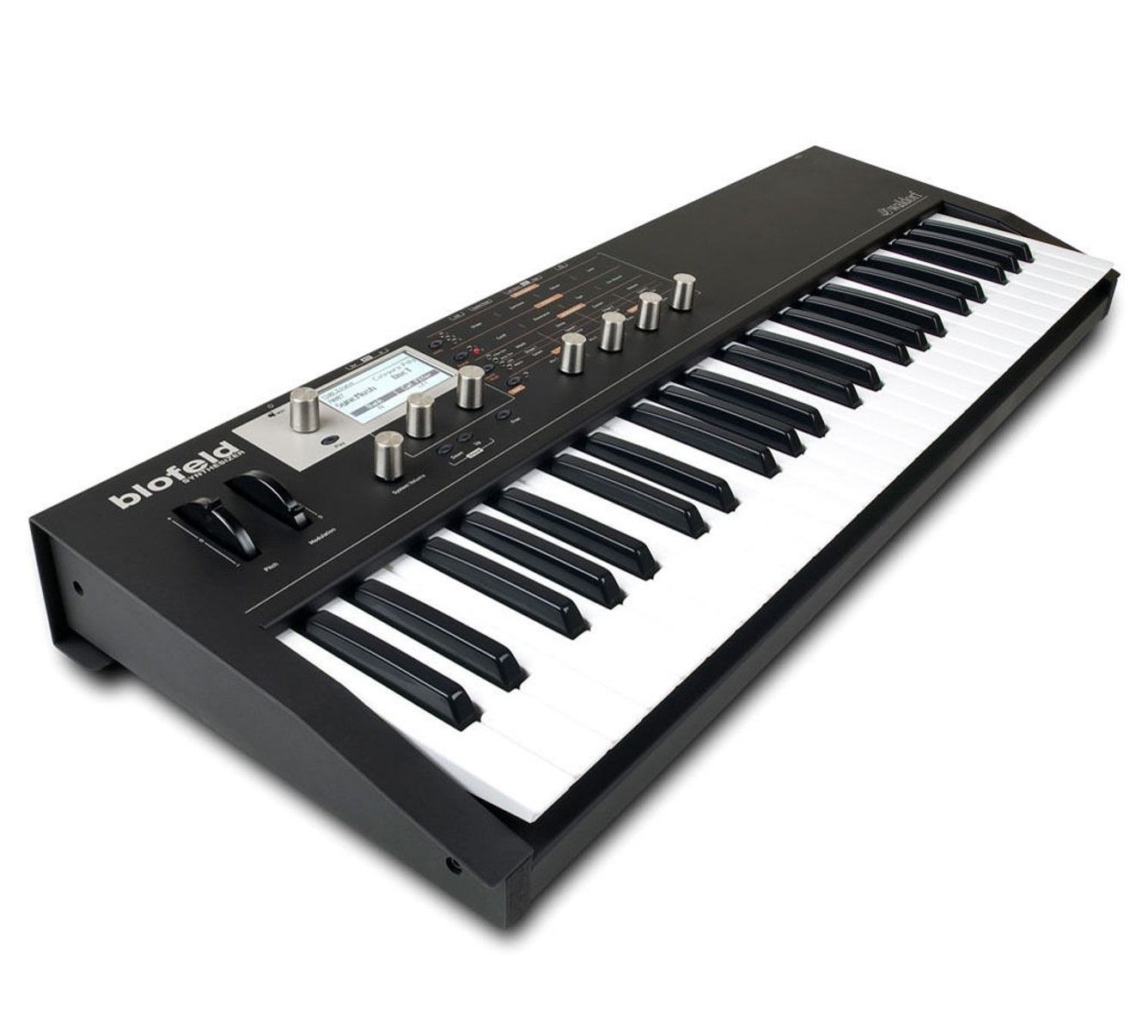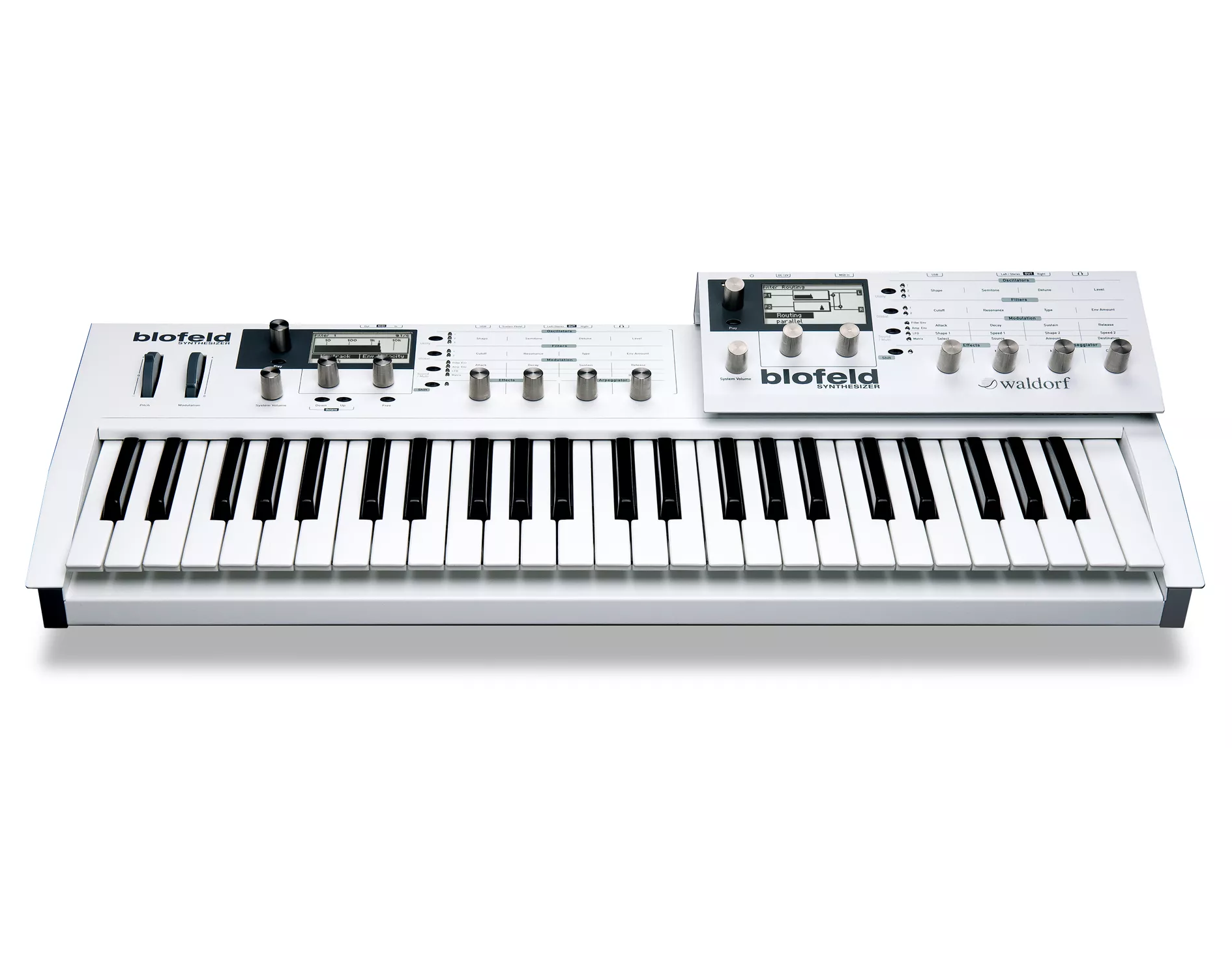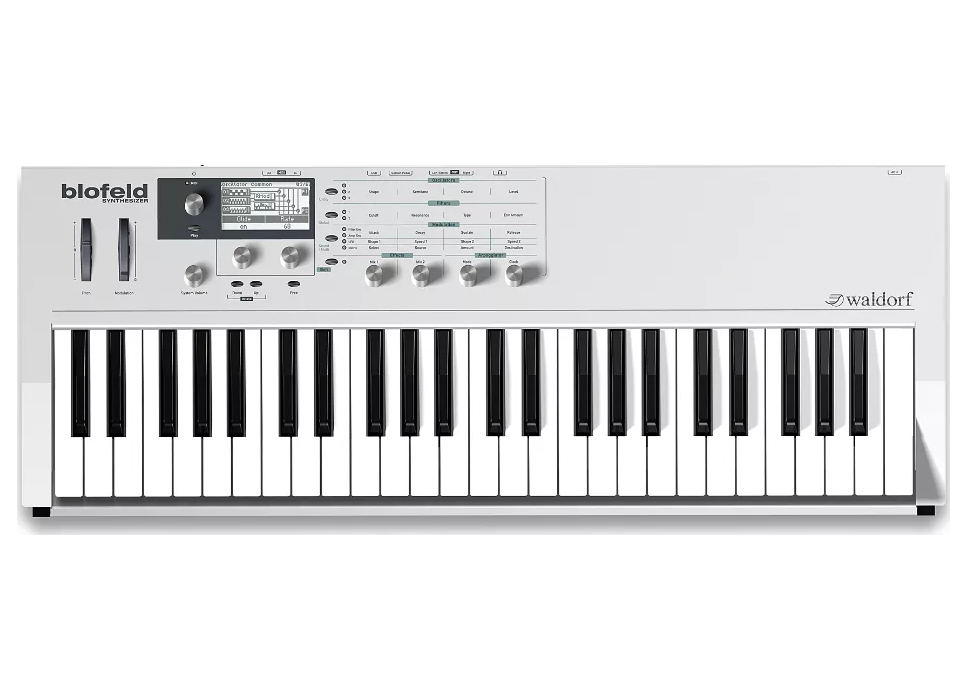Waldorf Blofeld
Electronic Instruments
Europe
Between 1901 and present
Video
The Waldorf Blofeld is a powerful and compact synthesizer that has become a favorite among electronic musicians and producers worldwide. Known for its rich sound design capabilities, extensive modulation options, and robust build, the Blofeld stands as a testament to Waldorf’s legacy in synthesizer innovation.
Description
The Waldorf Blofeld is a digital synthesizer that utilizes wavetable and virtual analog synthesis to produce a wide range of sounds. It is available in both desktop and keyboard versions, offering versatility for studio and live performance setups. The Blofeld features a sleek, minimalist design with a metal chassis, a crisp OLED display, and an intuitive interface centered around a matrix-style editing system. Despite its compact form, it provides an extensive array of controls, allowing users to sculpt and tweak sounds in great detail. With its high-quality sound engine and affordability compared to other synthesizers in its class, the Blofeld has gained a loyal following among musicians and sound designers.
Type of Instrument
The Blofeld falls under the category of synthesizers, specifically a digital synthesizer with wavetable synthesis and virtual analog modeling. It is a subtractive synthesizer at its core but incorporates elements of wavetable synthesis, a hallmark of Waldorf’s designs. This hybrid approach gives the Blofeld a unique sonic character, capable of producing everything from classic analog-style tones to futuristic digital textures.
History
The Waldorf Blofeld’s roots can be traced back to the evolution of synthesizer technology in Europe, particularly Germany, where Waldorf has been a key player in synthesis innovation since the 1980s. The Blofeld was released in the 21st century, building on the legacy of Waldorf’s earlier synthesizers, such as the Microwave and Q series. The company’s history in wavetable synthesis dates back to the late 20th century when PPG (Palm Products GmbH) introduced the concept, later adopted by Waldorf. The Blofeld was designed to bring the best of these synthesis techniques into an affordable and portable format, making it accessible to a wider audience of musicians and producers.
Construction
The Waldorf Blofeld is built with durability and performance in mind. The desktop version features a sturdy metal enclosure, ensuring it can withstand the rigors of travel and live performances. The keyboard version adds a high-quality semi-weighted keybed with aftertouch, enhancing playability. The front panel hosts a clear OLED display, providing real-time feedback on parameter adjustments. The primary method of navigation is through an encoder and a matrix-based interface, where users can access various synthesis parameters efficiently. The synthesizer offers a variety of connectivity options, including MIDI input/output, USB, and stereo audio outputs, making it adaptable to different studio and live setups.
Types
The Waldorf Blofeld comes in two main versions:
Desktop Version: A compact, knob-driven module without a keyboard, ideal for studio integration or as a module for MIDI controllers.
Keyboard Version: Includes a 49-key semi-weighted keyboard with aftertouch, making it a standalone performance synthesizer with additional playability.
While both versions share the same sound engine and features, the keyboard version provides more hands-on playability, which can be crucial for live musicians.
Features
The Blofeld boasts a comprehensive feature set that makes it a powerful tool for sound design. Some of its standout features include:
Three Oscillators Per Voice: These oscillators support traditional waveforms, as well as extensive wavetables derived from classic Waldorf synthesizers.
Dual Multi-Mode Filters: The filters offer various modes, including low-pass, high-pass, band-pass, and comb filtering, allowing deep sonic shaping.
Extensive Modulation Matrix: Users can route numerous modulation sources to destinations, enabling complex and evolving sound textures.
Arpeggiator: A programmable arpeggiator with intricate pattern capabilities, useful for rhythmic and melodic sequencing.
Polyphony and Multitimbrality: Up to 25 voices of polyphony and 16-part multitimbral capabilities make it versatile for layering and complex arrangements.
Effects Engine: Includes reverb, delay, chorus, and overdrive, enhancing the overall sound design possibilities.
Sound Production
The Blofeld generates sound through a combination of virtual analog and wavetable synthesis. The oscillators produce raw waveforms, which are then shaped by filters, envelopes, and modulation sources. The signal can be further processed using onboard effects, resulting in a wide spectrum of sounds ranging from lush pads and evolving textures to aggressive basses and cutting leads. Its ability to manipulate wavetables allows for unique timbral shifts, making it a go-to synthesizer for experimental and electronic music.
Playing Methods
The Blofeld can be played using different methods, depending on the version and user setup. The keyboard version allows for expressive performance with velocity sensitivity and aftertouch, while the desktop version is typically controlled via an external MIDI keyboard or sequencer. Additionally, users can program and trigger sequences using the arpeggiator and modulation matrix, making it a flexible tool for both live performance and studio production.
Roles in Music
The Blofeld is widely used across various genres, from electronic and ambient music to film scoring and experimental compositions. Its ability to produce rich, evolving textures makes it a favorite for atmospheric and cinematic sounds. In electronic dance music, the Blofeld’s powerful basses and leads are highly valued. It is also used in progressive rock and fusion genres, where its deep modulation capabilities allow for expressive and dynamic performances. Due to its multitimbral nature, it is an excellent tool for layering sounds, making it an essential component in modern music production.
The Waldorf Blofeld remains an influential synthesizer due to its affordability, robust feature set, and deep sound design capabilities. Whether in the hands of a seasoned synthesist or a beginner exploring the world of synthesis, the Blofeld offers endless creative possibilities, making it a timeless instrument in the ever-evolving world of music technology.
FAQ
What type of instrument is the Waldorf Blofeld?
The Waldorf Blofeld is a digital synthesizer known for its wavetable synthesis. It offers a broad spectrum of sounds, from analog emulations to complex digital textures.
What kind of music is the Waldorf Blofeld used for?
The Waldorf Blofeld is widely used in electronic, ambient, experimental, and cinematic music. Its versatile sound engine allows for deep modulation and intricate sound design.
What role does the Waldorf Blofeld play in music production?
The Blofeld serves as a powerful sound design tool, providing rich textures and evolving pads. It enhances productions with unique tones, making it a favorite for synthesists and producers.
 Links
Links
References
Other Instrument
Categories




















